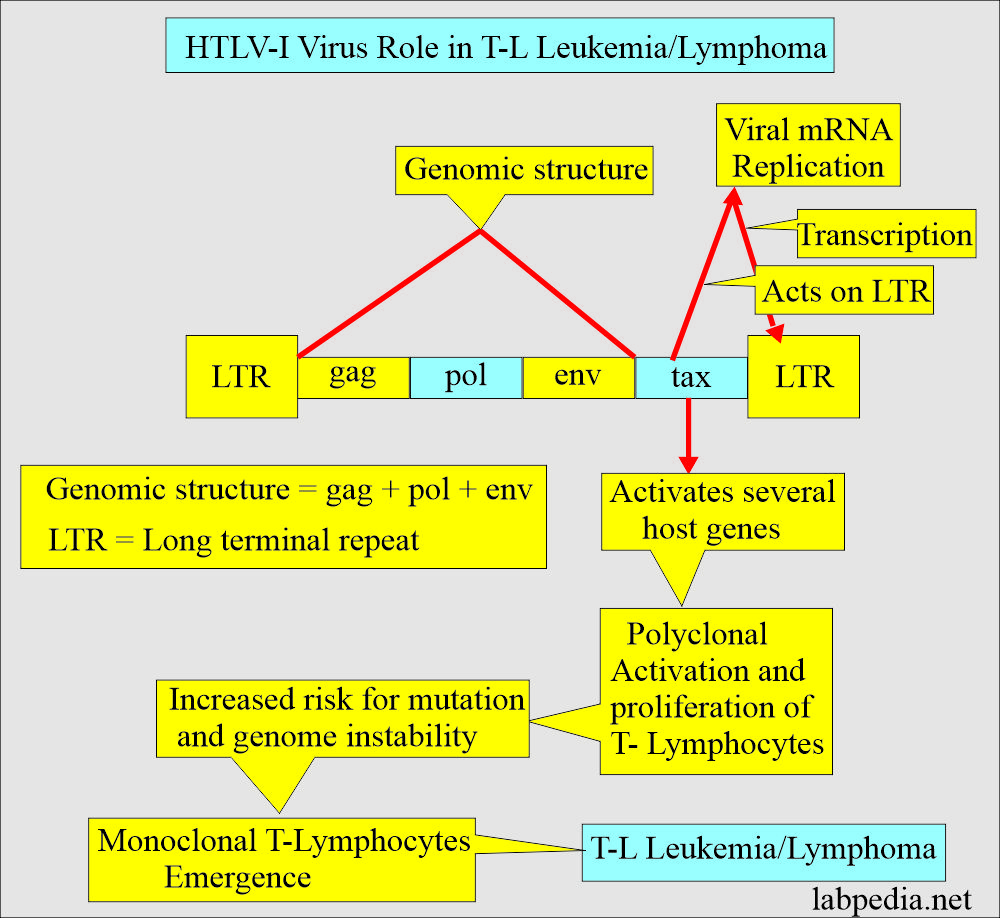Human T-Cell Lymphotropic Virus (HTLV I/II)
Human T-Cell Lymphotropic Virus (HTLV I/II)
What sample is needed for the Human T-cell Lymphotropic Virus (HTLV I/II)?
- The serum of the patient is needed.
- A random sample may be used.
What is the Indication for Human T-cell lymphotropic Virus (HTLV I/II)?
- This is used to diagnose a certain type of leukemia (T-cell leukemia).
- To diagnose demyelinating neurological disease.
How will you define Human T-cell lymphotropic Virus (HTLV)?
HTLV-I
- HTLV-1 was isolated in 1980.
- This virus is closely related to retroviruses and is mostly like HIV-I.
- Its transmission is also like HIV-I.
- HTLV-I lymphotropic retrovirus is the causative agent of cutaneous T-cell lymphoma in adults and a nervous system degenerative disorder called tropical spastic paraparesis.
HTLV-II
- HTLV-II was isolated in 1982.
- It is not conclusively associated with specific diseases.
HTLV-III
- HTLV-III was the cause of acquired immune deficiency syndrome (AIDS).
How will you describe the pathophysiology of the Human T-cell lymphotropic Virus (HTLV)?
- These are oncogenic RNA retroviruses:
HTLV-I
- It is associated with T-cell leukemia/ lymphoma.
- It is endemic in certain parts of Japan and the Caribbean basin.
- There are large lymphocytes and multilobulated nuclei like monocytes.
- It is rarely associated with neurologic conditions like tropical spastic paraparesis.
HTLV-II
- It is associated with the following:
- There are no clear-cut associations, but they are seen in a few conditions.
- Demyelinating neurological disorder (tropical spastic paraparesis).
- Hairy cell leukemia.
- This human retrovirus belongs to the Retroviridae family in the genus Deltaretrovirus.
- Retroviruses are RNA viruses with the reverse transpeptidase enzyme. This enzyme converts RNA viruses to DNA viruses, which incorporate into the host genome and mostly affect T-lymphocytes.
What is the difference between HTLV-I and HIV-I?
- HTLV-I does not cause depletion of the T-helper cells (CD4+ cells).
- It is generally not associated with immunosuppression.
- It does not cause AIDS syndrome.
- The antibodies do not indicate HIV-I infection or risk of AIDS.
- This is endemic in southern Japan, a Caribbean island, South America, and areas of Africa.
What is the distribution of the HTLV-I/II?
- HTLV-I is found predominantly in:
- Southern Japan.
- Some of the Caribbean islands.
- Parts of Central and South America (8% to 33%).
- Sub-Saharan Africa.
- >10% of the people in the endemic area are seropositive. This virus is found in 50% of the relatives of virus-positive leukemic patients.
- In the USA, HTLV-I is found in I/V drug abusers in 20% to 25%, female prostitutes in 0 to 25%, and Native Americans in 1% to 3%.
- HTLV-II currently has no disease association. There are several suggestions.
What is the mode of spread of HTLV-I and II?
- The spread of HTLV-I/II is like HIV by contaminated blood products.
- Body fluids contaminations.
- Intravenous drug use.
- HTLV-I is seen in I/V drug users in the USA (20% to 25%).
- HTLV-I has also been seen in prostitutes (7%).
- Sexual transmission. This route is less frequent.
- Breastfeeding. There is a risk of 20% spread to infants depending upon the duration of breastfeeding.
- In the USA, HTLV-I has been found in:
- Patient with ATL (adult T-cell leukemia).
- Intravenous drug users.
- Donated blood products.
- There is a 40% to 60% chance of seroconversion in the contaminated blood.
- While more risk to the immunocompromised patient.
- Even in healthy persons.
- In the case of transplantation of the liver, kidneys, and lungs.
What is the role of HTLV-I for T-L leukemia/lymphoma?
- Like other retroviruses, the HTLV-I genome structure consists of gag, pol, env, and a long terminal repeat (LTR).
- There is another region labeled as the tax (TAX) gene.
- This tax gene can cause viral replication and also acts as LTR.
- There is a transcription of the viral mRNA.
- Tax protein also activates several host genes in the lymphocytes.
- The activation and proliferation of the T-lymphocytes (CD4+) are also observed.
- This HTLV-I virus causes the expansion and the nonmalignant proliferation of the T-L (CD4+).
- There is an increased risk of mutation and gene instability.
- Ultimately, there is the emergence of the monoclonal T-L, which leads to T-L leukemia/lymphoma.
What is the normal for Human T-cell lymphotropic Virus?
- Antibodies are negative.
How will you make a diagnosis of the Human T-cell lymphotropic Virus?
- Serologic tests show HTLV-I antibodies by ELIZA.
- HTLV-I antibodies are seen in the following:
- Adult T-cell leukemia/lymphoma.
- Degenerative neurological diseases are called Tropical spastic paraparesis in Caribbean islands.
- It is seen in 5% of the general population and 15% of older people.
- HTLV-I myelopathy is seen in Japan.
- <15% of the general population of Japan and <30% of the older people.
- It is seen in prostitutes in the USA
- These are seen in I/V drug abusers.
- It is seen in multiple blood transfusions.
- Rarely seen in homosexual males.
- These antibodies are not seen in hemophiliacs.
- It is seen in 0.025% of random blood donors.
- These tests also detect HTLV-II.
- A western blot test is done to confirm the serologic tests.
- The nucleic acid probe with PCR enhancement is the most sensitive test to differentiate HTLV-I and HTLV-II.
Where will you see Positive HTLV antibodies?
- Acute HTLV infection.
- HTLV-I
- Adult T-cell leukemia.
- Tropical spastic paraparesis.
- Hairy cell leukemia.
Questions and answers:
Question 1: What is the role of HTLV-I/II virus in humans?
Question 2: What is the role of HTLV-I virus?

